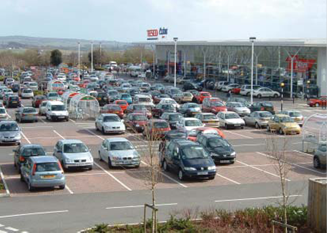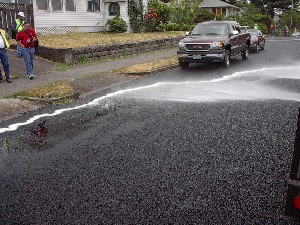Permeable brick
Superstore, Exeter
Engineers: White Young Green
Drainage Design: Interpave Member
Subgrade (ground) conditions: Rock
Particular constraints: a discharge restriction into a sewer was applied by the Environment Protection Agency demanding additional storage on site
Constructed in: 2006
Techniques: Optimisation of gradients to create additional storage within the CBPP (concrete block permeable paving) and elimination of conventional drain run excavation within rock. The scheme involved an extension to an existing superstore car park. The new parking area joined the existing car park at a gradient of approximately 1:50. Due to the slope of the site and the discharge restriction imposed, the usual hydraulic design depth was not adequate for the entire site. Therefore a system was designed so that the lower edge of the car park had additional sub-base material for water storage. To achieve this end, the subgrade gradient was slackened to 1:125 whilst keeping the CBPP surface at 1:50, making it visually consistent.

Permeable Asphalt
Westmoreland neighborhood, Portland, Oregon
Permeable asphalt location in this project: North Gay Avenue
During the summer of 2005, the City of Portland completed paving four blocks of North Gay Avenue where Environmental Services installed large-diameter sewer pipes in 2001. The project area is on Gay between North Wygant and North Sumner Streets. The project is a joint effort of Environmental Services, the Portland Office of Transportation, and the Portland Water Bureau. Parker-Northwest Paving of Oregon City was the City’s contractor.
The North Gay Avenue Pervious Pavement Pilot Project had two main goals:
1. To permanently re-pave streets damaged during the sewer work in 2001. The old concrete streets cracked badly, and the current asphalt is of temporary quality.
2. To provide information on how porous concrete and asphalt perform as a street surface. Porous pavement allows rain to soak through street and into the ground.

Water sprayed from a flusher truck disappears into the new pervious asphalt pavement on North Gay Avenue before it reaches the gutter.
With porous pavement, most or all of the stormwater will filter through the street surface into layers of rock below the street, and then into the ground. The existing storm inlets will remain to take any excess runoff. |

